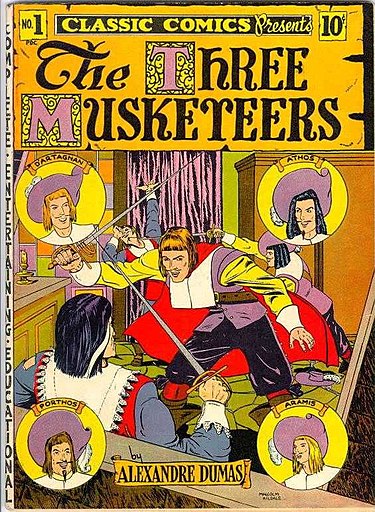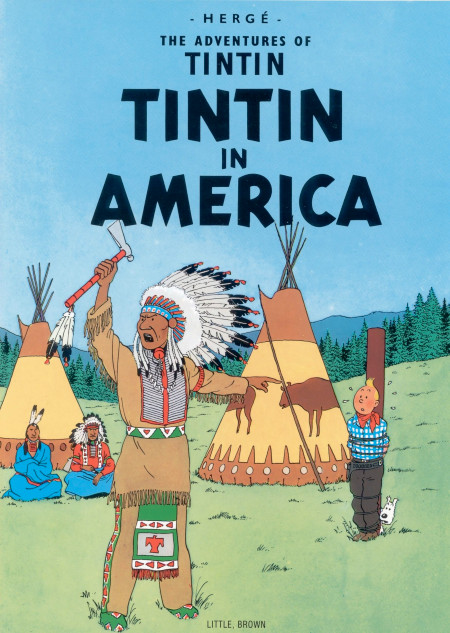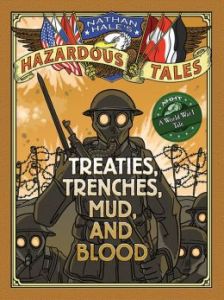When I was a kid, back in the day, “comic books” did not have a great reputation. In fact, in 1949 a book called Seduction of the Innocent, by psychologist Fredric Wertham, sent a groundswell of concerned parents to their children’s comic stash, looking for hidden (or not-so-hidden) sexual themes and violent content. At best, comics were an accessory of childhood, like cream soda, to be discarded once one had developed a more mature taste.

For sure, the medium had its share of extremes and perversions, and more than its share of shapely females in skin-tight outfits. But many PR firms had caught on to its educational potential, as demonstrated in two-color promotional works like “The Story of Electricity” or “The United States Banking System.” And in 1941, publisher Albert Kantor conceived the “Classic Comics” series (later Classics Illustrated) as a way to introduce young children to great works of literature. Beginning with The Three Musketeers, the series ran for 30 years and produced 169 titles. Classics Illustrated introduced one young reader (me) to Ivanhoe, A Tale of Two Cities, and Jane Eyre at an early age. Two of those titles I eventually read in the original, after I was already familiar with the basic plot and could enjoy the work for its literary quality.

The business has changed a lot since then; comic books have grown into graphic novels, a genuine art form branching off into a full spectrum of styles, moods, and genres. Also quality and value. Many parents still regard them as, at best, a barely-tolerated inferior product. Or, at worst, a distraction that will derail good reading habits from an early age if they allow their kids to indulge.
But I don’t think that’s true. My artistically-inclined son devoured comics, and also real books, including great literature. Betsy and Megan can say the same about their boys.
Betsy: I think a lot of that discussion depends on a few key factors:
- Quality of graphic novel (like any genre, there are good examples/bad examples—both in terms of content and in terms of craftsmanship; something like Tintin is chock full of amazing vocabulary and great storytelling, for instance)
- Purpose of reading them: recreational reading? Reading should be recreational at times, as long as graphic novels aren’t the only thing the kid wants to read (and a well-crafted graphic novel is still requiring some mental heavy lifting). For more intentional reading (like, for school), then I’d consider what the general plan is: are we introducing a literary work that we’re going to go on to actually read? Are we bothered by the fact that kids will now have particular images in their minds when they read the literary work? Are we using the book as an example of how someone might depict a story we’ve just read—like Hinds’ Poe book or a Shakespeare adaptation? All worthwhile considerations, but no reason to dismiss all comics out of hand.
- Graphic novels can be a great way to learn about other cultures or history in a powerful format. Don Brown’s Hurricane Katrina book was pretty well done. So is Boxers/Saints. And the storytelling in Around the World is really interesting because readers get a visual for the different modes of transport in addition to the scenery
- Our culture is such a visual one that learning to “read” pictures is important! There are so many artistic factors to discuss!
Megan: I don’t think graphic novels are necessarily dumbing down any more than a text-only abridged version of a classic, and I am convinced they can be a great boon to fledgling readers. My boys are entranced with Tintin and Calvin and Hobbes and have moved into a relatively sophisticated reading level without prompting because of the adventures and humor. I think it helps bridge the narrative so they keep moving through the story without getting frustrated over words they are still learning. (Besides, “Pow” is a pretty easy sight word. 🙂
Back to Janie:
I’m wondering if there’s something in the Reformed/Protestant mindset that distrusts pictures? Part of the Reformation’s quarrel with the Catholic Church was the latter’s use of images and statues as “books for the masses”—a way to instruct the illiterate. We agree that when it comes to theology or spiritual content, a picture is not worth a thousand words. Words are the chief means that God chooses to communicate with us, primarily through Scripture. But maybe not the only means. If Christians are called to be “good stewards of his varied grace” (I Peter 4:10), we can also be grateful receivers of his varied grace as demonstrated by the artists and storytellers whose “good and perfect gifts” come from God Himself.

Back to the original question: are graphic novels “literature”? Not in the traditional sense, but traditions are always expanding. Will a judiciously-balanced reading diet that includes some graphic novels spoil a youngster for “real reading”? In our experience, we haven’t found that to be the case. Graphic novels are not a substitute for words on a page, but an alternate form of storytelling, like film and theater. Often they can even enhance the reader’s experience: Gareth Hinds’ dramatic treatment of The Iliad can prep a young reader to encounter the original later on. Nathan Hale’s Trenches, Treaties, Mud and Blood can plant images of the horror of World War I that will resonate when reading about it. Tintin, as Betsy noted above, takes the reader on adventures in exotic places with no sacrifice of vocabulary or character development. The Faithful Spy, by John Hendrix, presents the dilemmas facing Dietrich Bonhoeffer with a striking blend of image and text that could inform a teen’s later reading of The Cost of Discipleship. The graphic-novel field is now so wide and varied that to ignore them is to cut a chunk out of cultural education. And it’s missing out on some great storytelling, too.
For more on this subject, see “The Power of a Picture.” Also see our review of Scott McCloud’s Understanding Comics.
Stay Up to Date!
Get the information you need to make wise choices about books for your children and teens.
Our weekly newsletter includes our latest reviews, related links from around the web, a featured book list, book trivia, and more. We never sell your information. You may unsubscribe at any time.
Support our writers and help keep Redeemed Reader ad-free by joining the Redeemed Reader Fellowship.
Stay Up to Date!
Get the information you need to make wise choices about books for your children and teens.
Our weekly newsletter includes our latest reviews, related links from around the web, a featured book list, book trivia, and more. We never sell your information. You may unsubscribe at any time.
We'd love to hear from you!
Our comments are now limited to our members (both Silver and Golden Key). Members, you just need to log in with your normal log-in credentials!
Not a member yet? You can join the Silver Key ($2.99/month) for a free 2-week trial. Cancel at any time. Find out more about membership here.
7 Comments
Leave a Comment
You must be logged in to post a comment.




As a YA librarian who loves comics, thanks for this interesting article!
I’d agree that comics, graphic novels or ‘sequential art’ just to be all high brow, are a separate medium. There are things that the unattended to word can accomplish without a picture to distract the mind or fill in the blanks, but there is also a unique power in images and the use of them to tell stories, as well as combination of words with pictures as comics does.
Good suggestions on Boxers and Saints and Scott McCloud’s work BTW! I also like Doug TenNapel (of Earthworm Jim fame), whose work is off the wall but also incorporates some Christian themes into it.
Thanks Evan–we’re fans of Doug TenNapel too. Check out our interview: https://redeemedreader.com/2013/02/words-and-pictures-a-talk-with-doug-tennapel/
Thanks, that was a great interview!
Graphic novels are absolutely literature. Look at stuff like V For Vendetta, which is every bit as powerful as 1984, or Neil Gaiman’s epic Sandman series, which is about as high fantasy literature as it gets, weaving tales drawing from Egyptian, Norse and Greek mythology. Even superhero comics can be literature and writers like Alan Moore, Frank Miller and Grant Morrison (who I personally can’t stand!) have pushed the boundaries time and time again, altering the perception of comics forever. I would urge anyone on the fence to read Blankets by Craig Thompson. A 600 page coming of age memoir, with themes of love, lost faith and abuse on every page. Or maybe try The Pride Of Baghdad, the (true) story of a group of lions who escaped from a zoo during the Iraq war, or From Hell, Alan Moore’s epic Jack The Ripper story. Comics and graphic novels are incredible forms of literature, and every bit as relevant as traditional stories.
Alex – We agree! (though some of our readers are skeptical). I’m not so fond of some of the recent adaptations of children’s books like The Giver and A Wrinkle in Time, because they don’t add much dimension to the story, but the format works great for original stories and memoir (New Kid, Hey Kiddo), not to mention fantasy and sci-fi.
I’ve found that for kids and teens that have a harder time with reading due to dyslexia or other reading issues, a graphic novel adaptation of a classic work can be the perfect way to learn about the classic without struggling to actually reading the original. The “Manga Classics” series Count of Monte Cristo is one of my favorites.
My experience is the same! Otherwise I would know nothing about “Ivanhoe” except the 1950s movie version that I barely remember.